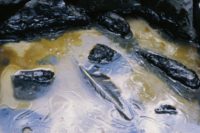New CSB video recreates Deepwater Horizon disaster

A narrated computer animation recreating the Deepwater Horizon blowout on April 20, 2010 depicts how high-pressure oil and gas from the Macondo well in the Gulf of Mexico caused an explosion on the drilling rig that killed 11 workers and seriously injured 17 others. The rig burned for two days, eventually sinking and triggering the largest oil spill in U.S. history.
The 11-minute animation produced by the U.S. Chemical Safety Board (CSB) illustrates how the Deepwater Horizon’s blowout preventer failed to seal the well on the night of the accident because drill pipe buckled due to a mechanism known as “effective compression.” The video shows that the blowout preventer’s blind shear ram – an emergency hydraulic device with two sharp cutting blades meant to cut the drill pipe and seal the well – likely did activate on the night of the accident. However, because the drill pipe was buckled and off-center inside the blowout preventer, it was trapped and only partially cut. The video explains how this failure directly led to the massive oil spill and contributed to the severity of the incident on the drilling rig.
The video notes that although effective compression has previously been identified as a hazard in other drilling operations, it has never before been recognized as a problem affecting drill pipe during well operations. CSB investigators say this is an important finding because the same conditions that buckled the drill pipe during the Deepwater Horizon accident could occur at other drilling rigs – even if a crew successfully shuts in a well. The video warns this could make existing blowout preventer designs less effective in emergency situations.
Looking for a reprint of this article?
From high-res PDFs to custom plaques, order your copy today!






